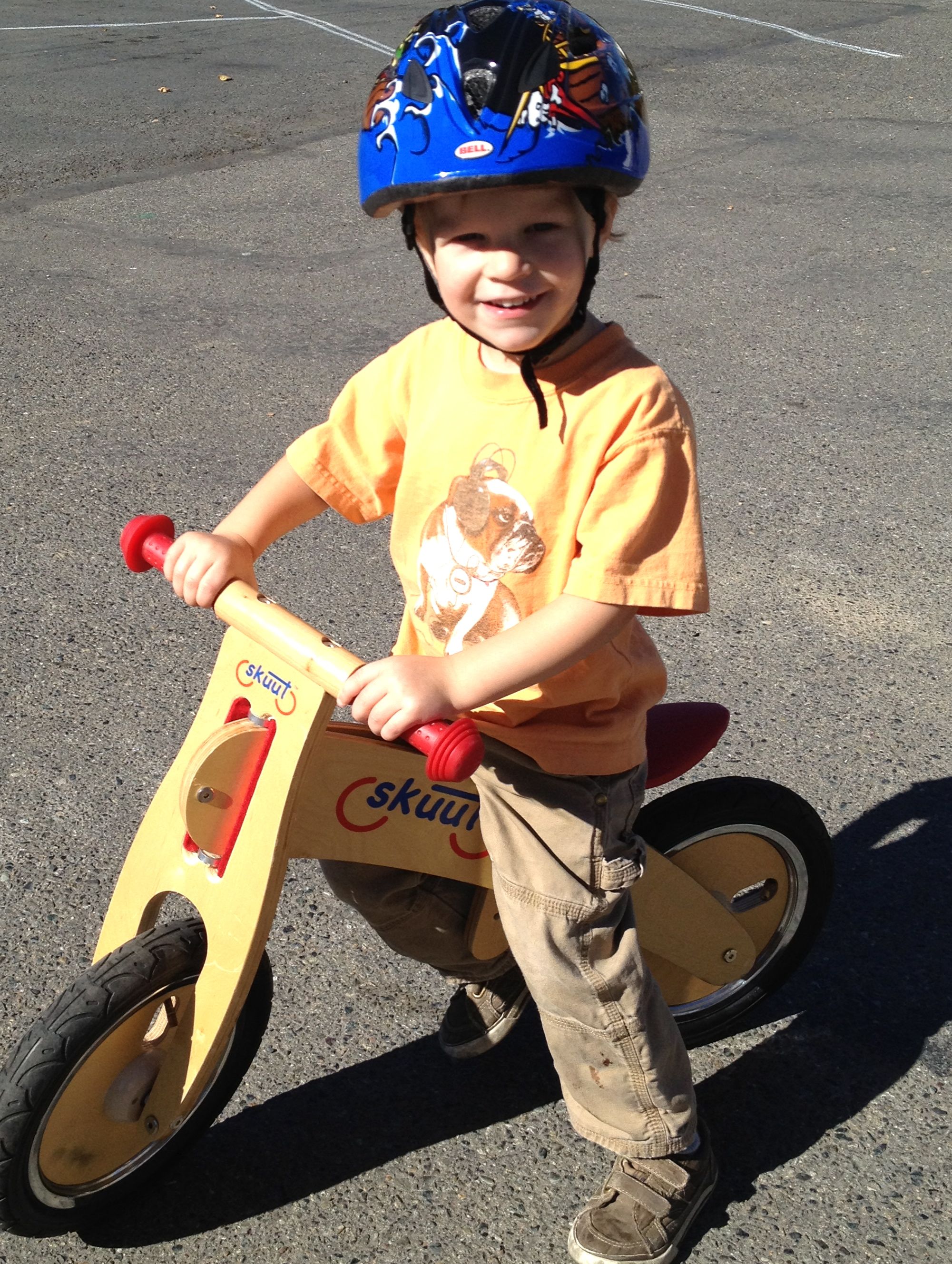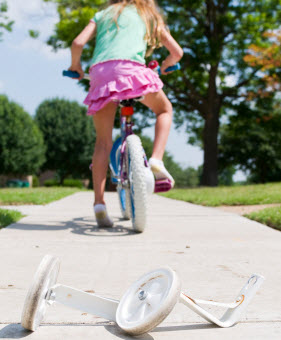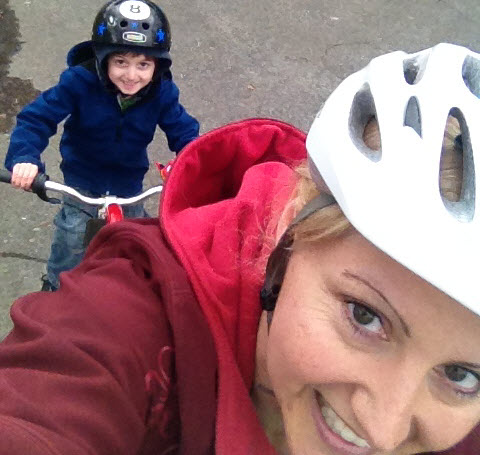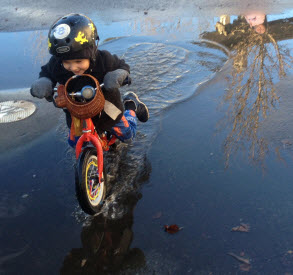 "Time to take the training wheels off."
"Time to take the training wheels off."
This phrase used to be a milestone of childhood. But now there's a new bicycle on the block designed to bypass training wheels altogether: balance bikes— pedal-less, brake-less bicycles designed for very young kids.
Balance bikes, like scooters, separate steering and balance from the skills of pedaling and braking. Because kids as young as two can learn to push off, balance and glide, they get plenty of experience by the time they're ready for a pedal bike.
Anne and Tim King blog about their family cycling adventures at CarFreeDays.com. They taught their daughter (now 12) to ride with training wheels. When it came time to take them off, they spent a whole afternoon at the park helping her coast down a grassy slope until she could balance on her own.
When their son (now 9) learned to ride, it was on a balance bike. “There was an amazing difference," says Anne. "He spent about six months on the balance bike, then we took him to the playground with his big bike and he just rode away."
Early balance bikes
The balance bike principle isn't unique; the earliest bicycles, in fact, were designed to be powered Flintstone-style — although these "dandy horses" experienced only a brief popularity in the 1800's before being replaced by their pedal-equipped cousins.
Today’s “balance bikes” started coming on the market around ten years ago, have exploded in popularity in recent years and are now a familiar staple of playgrounds and driveways.
But does a balance bike mean dispensing with training wheels altogether? Here are some tips for navigating the balance-bike world.
Choosing your child's first balance bike
 What bike to buy? There are more choices than ever.
What bike to buy? There are more choices than ever.
For very little kids, Mary Craig, Cycle and Nutrition Coach at Cycle University in Seattle, recommends a balance bike with a locked front wheel. "The misconception is that kids need strong legs," says Craig. "But the reality is that they need strong arms so they can steer and keep themselves going straight." Taking steering out of the equation at first can help a child master their new balance bike faster. Craig recommends the Early Rider, which has a wooden frame, pneumatic tires and a steering limiter on the front wheel ($159-$179).
Another choice for the very youngest riders is the plastic Bunzi Balance Trainer, which begins as a balance trike, then converts from 3 to 2 wheels when the child is ready. It's plastic, and is listed at $80.
![]() The wood-framed Wishbone 3-in-1 also starts with three wheels, then can be converted ($229).
The wood-framed Wishbone 3-in-1 also starts with three wheels, then can be converted ($229).
Bigger balance bikes are a bit more varied. Popular brands includeFirstBIKE, which is made of fiberglass and offered with or without a hand brake ($165); the wood-framed Skuut ($99). The Strider and KaZam are  both metal frames and run about $99. The KaZam also has a footrest in the frame to keep little feet out of the way while coasting.
both metal frames and run about $99. The KaZam also has a footrest in the frame to keep little feet out of the way while coasting.
Both wood and metal frames can be damaged if left out in the rain (through warp or rust), though light rain won't hurt them. Plastic and fiberglass frames are generally a little lighter than the others. Overall, the material isn't as important as getting a bike that fits your child well.
Make your own balance bike
 One of the cons of a balance bike is that unlike a bike with training wheels, it can't transform into a regular bike. On the other hand, though, a regular bike can easily become a balance bike.
One of the cons of a balance bike is that unlike a bike with training wheels, it can't transform into a regular bike. On the other hand, though, a regular bike can easily become a balance bike.
At CycleU, Craig teaches kids as well as adults who've never ridden the same way: by removing the pedals of their bike and dropping the seat down so their feet are flat. New riders are encouraged to go at their own pace. "We remind them that they're 100 percent percent in control," she says. "We don't touch the bike at all."
Once her students have mastered the balance, Craig reattaches the pedals.
Use training wheels judiciously
Most of us learned to ride on training wheels, which offer stability and a chance to master skills like steering and braking without the fear of falling. Fritz Rice, Sales Manager at Gregg’s Greenlake Cycle, sees a lot of kids having success with balance bikes these days, but he says that training wheels can still play an important role in learning to ride. "The thing to remember is that training wheels don’t just make a bicycle into a tricycle — they’re meant to be adjustable."
The method he suggests: Start with training wheels all they way down, but "as the child gets more comfortable, the Training Wheel Fairy should come a couple of times a week to raise the wheels up incrementally."
Rice said that training wheels could be used on their own with no problem. When the child is balancing on their own, the training wheels are ready to come off.
 Learning to pedal and brake
Learning to pedal and brake
Madi Carlson blogs about her family biking adventures at FamilyRide. Her sons (ages 3 and 5) both learned to ride on balance bikes. But, she says, "I will say that some pedaling is critical."
She recommends using a trail-a-bike (which attaches to an adult's bike) to help kids get that concept down. "We also used bikes with training wheels in the REI showroom a bit," she says.
Adjusting to the bigger size of the pedal bikes was another small hurdle for Carlson's boys. Their strategy: They took the pedals off at first so the boys could get used to the bigger bike and let them ride down a grassy hill.
"Just put them on and send them down so they can get used to the motion."
A final tip: Wait until you have time to devote to helping your kids learn to ride. "Repetition is key here," says Craig. "You need about 10-15 minutes a day. If you just go out on one sunny day, then don't practice again for a week because it's rainy, it won't help kids learn."
You can also consider a class or camp. Seattle-area options include family biking classes by Cascade Bicycle Club, Cycle University's Kids Learn to Ride classes, which start in May. Pedalheads offers summer camps around Seattle for kids of various cycling levels, from toddlers to young kids looking to take off their training wheels to more advanced riders. REI also offers occasional learn-to-ride classes.
 Ride as a family
Ride as a family
Learning to ride a bike is just the first step. "A lot of parents stop once the kids learn to ride," says Anne King. "Maybe the kid goes to practice a bit, but if the parents don't ride and take an interest in teaching the kids, that's it. Then kids get to middle school, and they don't have the bike handling skills they need to ride with their friends."
- Families can find safe and fun rides on the local paved trails like the Burke Gilman, and throughout the summer along Lake Washington Boulevard during Bicycle Sundays.
- The Seattle Family Biking Facebook page is a great resource for family-oriented cycling events like Kidical Mass, as well as a good place to ask questions.
- Tim and Anne King will also help organize an event called Fiets of Parenthood this September, where they'll have a variety of family bikes for interested people to try out. Check the Kings' blog CarFreeDays.com for more information when it's available.
 Tips for buying kid bikes on a budget
Tips for buying kid bikes on a budget
- Resist the temptation to buy a bike for your child to “grow into,” since they’ll have an easier time learning (and more fun) on a bike that’s the right size for them.
- Make sure safety gear such as helmets and pads are the right size. An improperly sized helmet can do more danger than good. (Tip: Seattle Children's Hospital organizes periodic free helmet fittings and giveaways.)
- Fritz Rice recommends trying out bikes in person rather than simply buying based on height, since kids have a wide ratio of limb and torso length, as well as a range of strength and coordination.
- Websites like Craigslist can be a treasure trove of kids' bikes. Madi Carlson notes that kids' bikes have great resale value on sites like Craigslist when you're ready to trade up to a larger size.
- Some bike shops like (in the Seattle area) Gregg’s Cycles have buyback programs so that each bike is an investment in the next. They also sell the refurbished bikes at a discount.
- Alternately, consider donating used bikes to an organization like Bikeworks, where kids can help repair donated bikes in order to earn a bike of their own. Bikeworks also has a rotating selection of kids bikes for sale in their store.
- When buying a trail-a-bike, Carlson recommends buying one that attaches to the adult bike's rear rack rather than seat post, since the latter skew slightly to the side and can feel unbalanced. The Carlsons use a Burley Piccolo.
- Kick scooters can be a great way to help build balance skills for older kids (ages 5-11).
See also
- 13 places to take your budding biker
About the author: Jessie Kwak is a Seattle-based freelance writer who blogs about bikes and crafts at Bicitoro.com.
Photo credits: From top top bottom: Boy on Skuut) (Elisa Murray), three balance bike models (bike websites), girl leaving training wheels behind (istockphoto); boy on trail-a-bike with mom (Madi Carlson, FamilyRide); boy with dad (Allison Holm, Seattle Travel Mom); dad and kids biking (Madi Carlson, FamilyRide).









